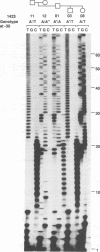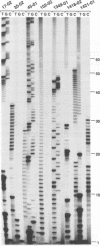Abstract
Sequences immediately adjacent to the human Xp/Yp telomere exhibit a high frequency of base substitutional polymorphisms, together with almost complete linkage disequilibrium, to create only a few diverged haplotypes. This sequence divergence has been used to develop a PCR-based system for mapping the distribution of the telomere (TTAGGG) and variant repeats (TGAGGG and TCAGGG) at the proximal end of the telomere repeat array. The distribution of these repeats is extremely variable. Almost all Xp/Yp telomeres are different, indicating a high mutation rate. Some telomere maps associated with the same flanking haplotype show similarities, identifying subsets of telomeres that share a recent common ancestry. Mechanisms underlying the rapid turnover of repeats at the proximal end of the Xp/Yp telomere include intra-allelic processes, such as slippage during replication. Inter-allelic exchanges may occur occasionally, but telomerase activity probably plays only a minor role in the germline turnover of proximally located telomere and variant repeats.
Full text
PDF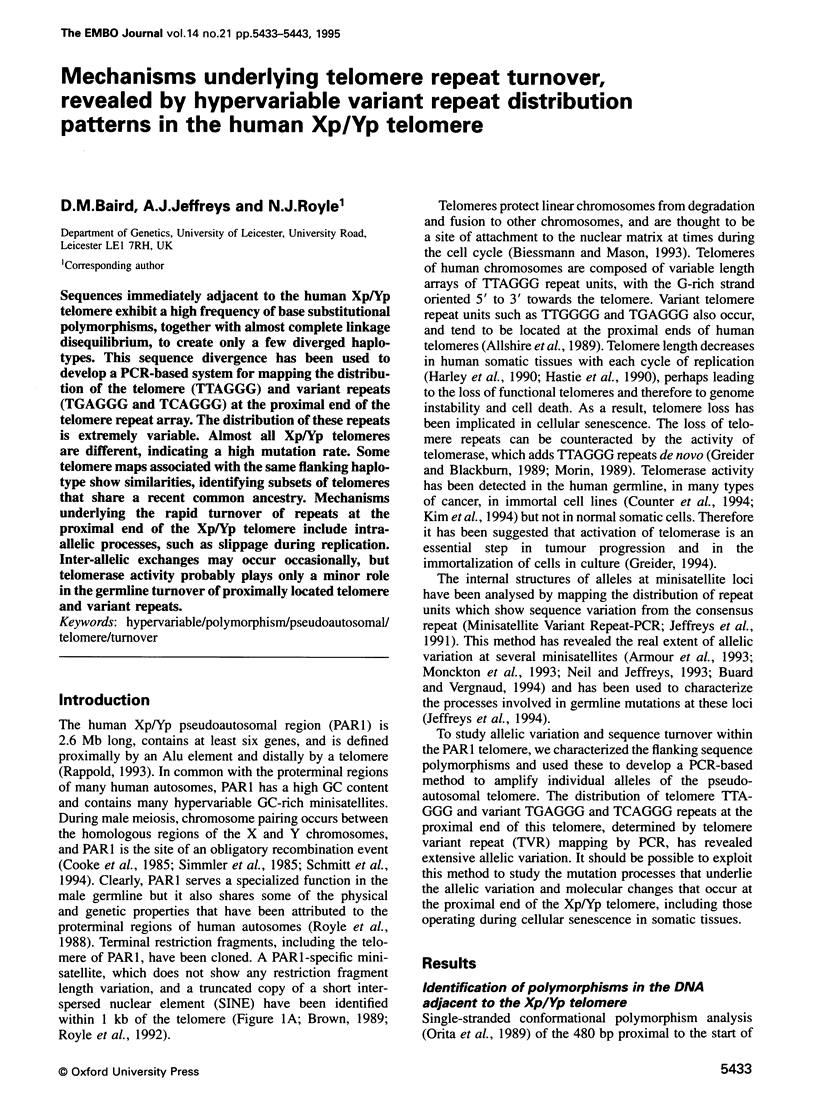
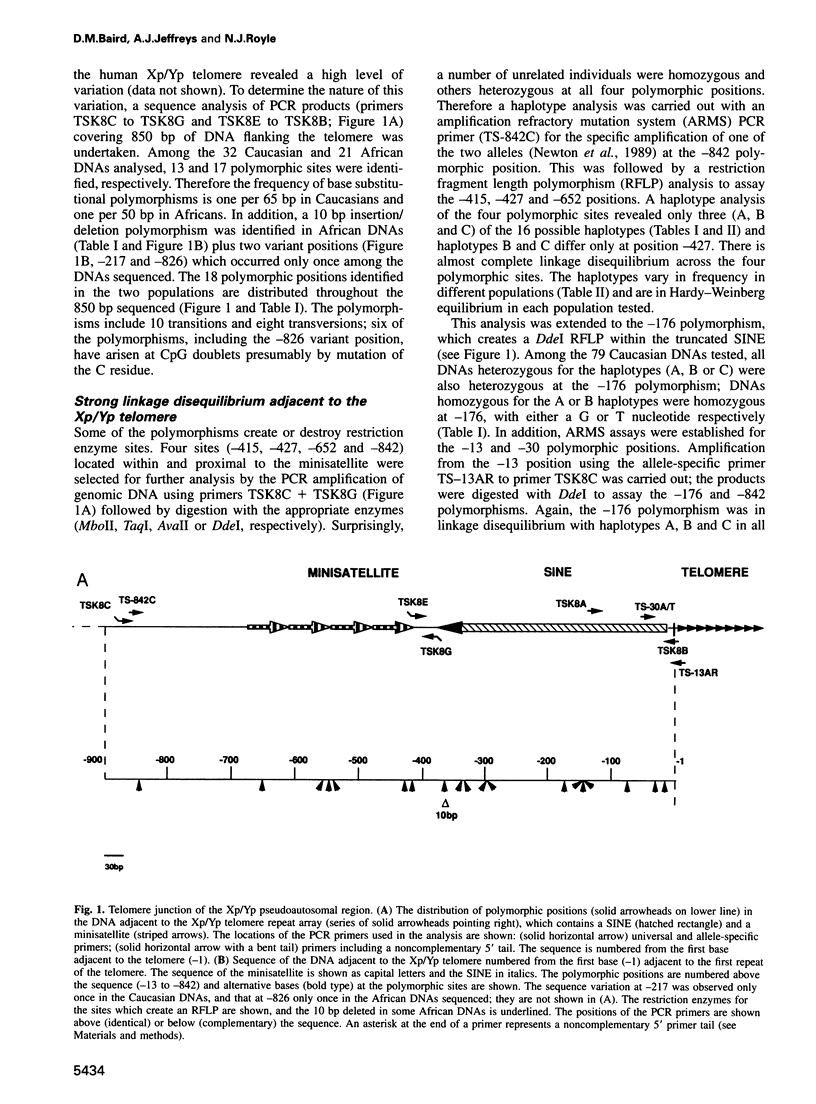



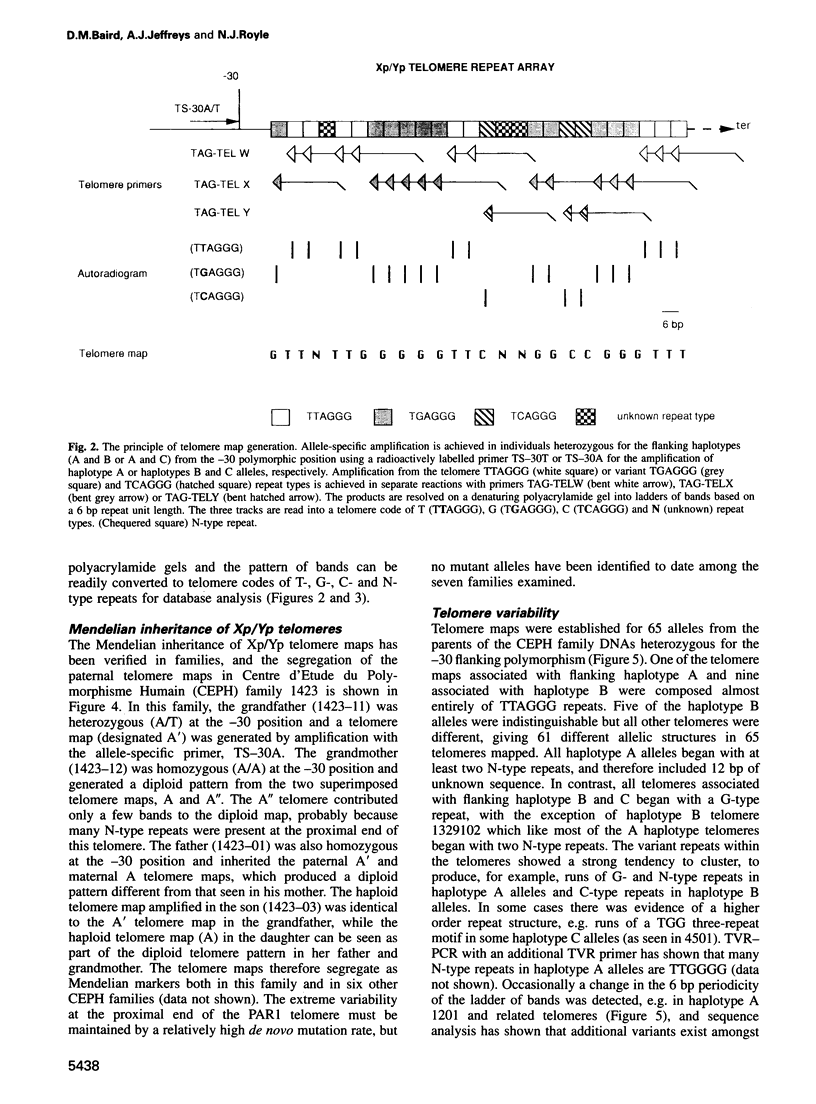
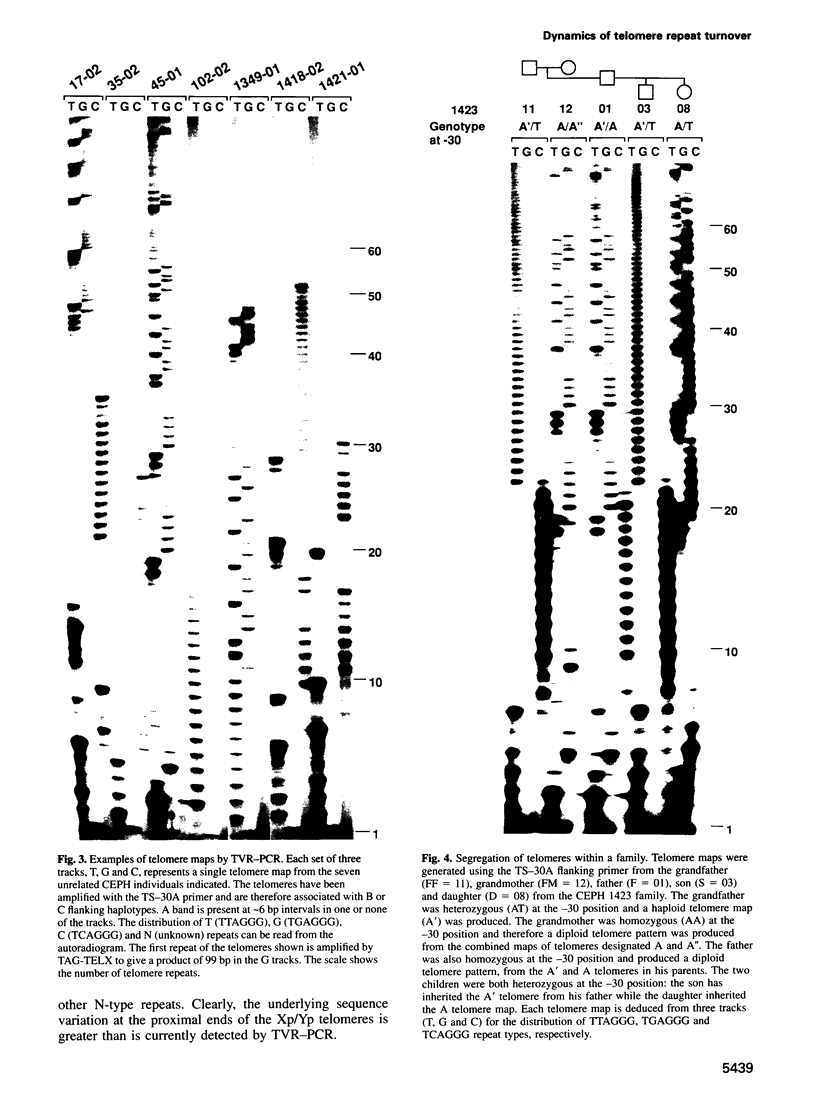


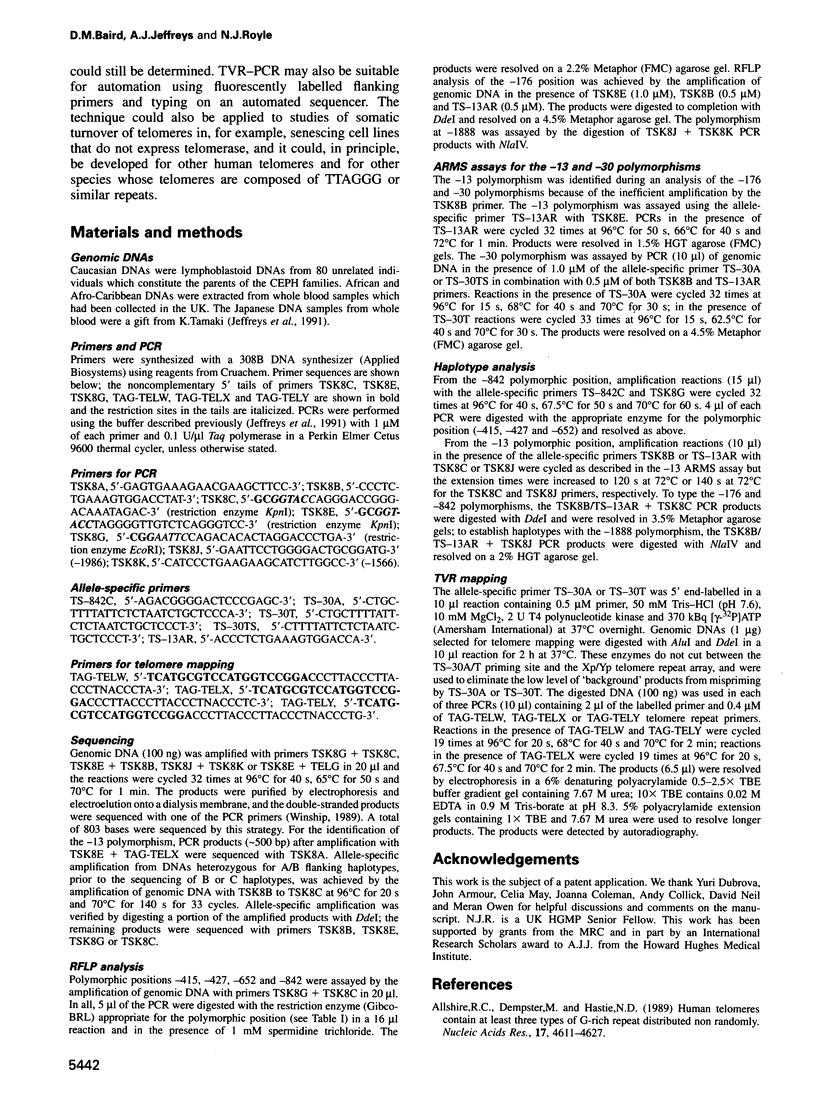
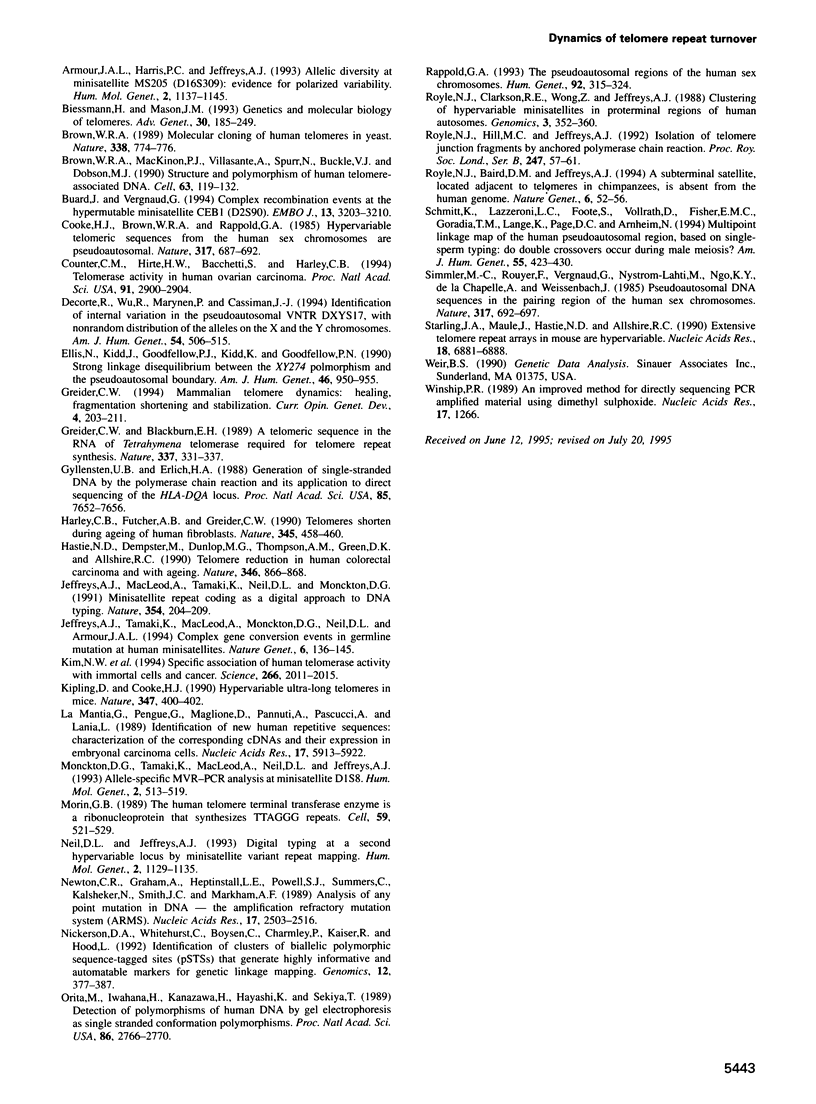
Images in this article
Selected References
These references are in PubMed. This may not be the complete list of references from this article.
- Allshire R. C., Dempster M., Hastie N. D. Human telomeres contain at least three types of G-rich repeat distributed non-randomly. Nucleic Acids Res. 1989 Jun 26;17(12):4611–4627. doi: 10.1093/nar/17.12.4611. [DOI] [PMC free article] [PubMed] [Google Scholar]
- Armour J. A., Harris P. C., Jeffreys A. J. Allelic diversity at minisatellite MS205 (D16S309): evidence for polarized variability. Hum Mol Genet. 1993 Aug;2(8):1137–1145. doi: 10.1093/hmg/2.8.1137. [DOI] [PubMed] [Google Scholar]
- Biessmann H., Mason J. M. Genetics and molecular biology of telomeres. Adv Genet. 1992;30:185–249. doi: 10.1016/s0065-2660(08)60321-1. [DOI] [PubMed] [Google Scholar]
- Brown W. R., MacKinnon P. J., Villasanté A., Spurr N., Buckle V. J., Dobson M. J. Structure and polymorphism of human telomere-associated DNA. Cell. 1990 Oct 5;63(1):119–132. doi: 10.1016/0092-8674(90)90293-n. [DOI] [PubMed] [Google Scholar]
- Brown W. R. Molecular cloning of human telomeres in yeast. Nature. 1989 Apr 27;338(6218):774–776. doi: 10.1038/338774a0. [DOI] [PubMed] [Google Scholar]
- Buard J., Vergnaud G. Complex recombination events at the hypermutable minisatellite CEB1 (D2S90). EMBO J. 1994 Jul 1;13(13):3203–3210. doi: 10.1002/j.1460-2075.1994.tb06619.x. [DOI] [PMC free article] [PubMed] [Google Scholar]
- Cooke H. J., Brown W. R., Rappold G. A. Hypervariable telomeric sequences from the human sex chromosomes are pseudoautosomal. Nature. 1985 Oct 24;317(6039):687–692. doi: 10.1038/317687a0. [DOI] [PubMed] [Google Scholar]
- Counter C. M., Hirte H. W., Bacchetti S., Harley C. B. Telomerase activity in human ovarian carcinoma. Proc Natl Acad Sci U S A. 1994 Apr 12;91(8):2900–2904. doi: 10.1073/pnas.91.8.2900. [DOI] [PMC free article] [PubMed] [Google Scholar]
- Decorte R., Wu R., Marynen P., Cassiman J. J. Identification of internal variation in the pseudoautosomal VNTR DXYS17, with nonrandom distribution of the alleles on the X and the Y chromosomes. Am J Hum Genet. 1994 Mar;54(3):506–515. [PMC free article] [PubMed] [Google Scholar]
- Ellis N., Kidd J., Goodfellow P. J., Kidd K., Goodfellow P. N. Strong linkage disequilibrium between the XY274 polymorphism and the pseudoautosomal boundary. Am J Hum Genet. 1990 May;46(5):950–955. [PMC free article] [PubMed] [Google Scholar]
- Greider C. W., Blackburn E. H. A telomeric sequence in the RNA of Tetrahymena telomerase required for telomere repeat synthesis. Nature. 1989 Jan 26;337(6205):331–337. doi: 10.1038/337331a0. [DOI] [PubMed] [Google Scholar]
- Greider C. W. Mammalian telomere dynamics: healing, fragmentation shortening and stabilization. Curr Opin Genet Dev. 1994 Apr;4(2):203–211. doi: 10.1016/s0959-437x(05)80046-2. [DOI] [PubMed] [Google Scholar]
- Gyllensten U. B., Erlich H. A. Generation of single-stranded DNA by the polymerase chain reaction and its application to direct sequencing of the HLA-DQA locus. Proc Natl Acad Sci U S A. 1988 Oct;85(20):7652–7656. doi: 10.1073/pnas.85.20.7652. [DOI] [PMC free article] [PubMed] [Google Scholar]
- Harley C. B., Futcher A. B., Greider C. W. Telomeres shorten during ageing of human fibroblasts. Nature. 1990 May 31;345(6274):458–460. doi: 10.1038/345458a0. [DOI] [PubMed] [Google Scholar]
- Hastie N. D., Dempster M., Dunlop M. G., Thompson A. M., Green D. K., Allshire R. C. Telomere reduction in human colorectal carcinoma and with ageing. Nature. 1990 Aug 30;346(6287):866–868. doi: 10.1038/346866a0. [DOI] [PubMed] [Google Scholar]
- Jeffreys A. J., MacLeod A., Tamaki K., Neil D. L., Monckton D. G. Minisatellite repeat coding as a digital approach to DNA typing. Nature. 1991 Nov 21;354(6350):204–209. doi: 10.1038/354204a0. [DOI] [PubMed] [Google Scholar]
- Jeffreys A. J., Tamaki K., MacLeod A., Monckton D. G., Neil D. L., Armour J. A. Complex gene conversion events in germline mutation at human minisatellites. Nat Genet. 1994 Feb;6(2):136–145. doi: 10.1038/ng0294-136. [DOI] [PubMed] [Google Scholar]
- Kim N. W., Piatyszek M. A., Prowse K. R., Harley C. B., West M. D., Ho P. L., Coviello G. M., Wright W. E., Weinrich S. L., Shay J. W. Specific association of human telomerase activity with immortal cells and cancer. Science. 1994 Dec 23;266(5193):2011–2015. doi: 10.1126/science.7605428. [DOI] [PubMed] [Google Scholar]
- Kipling D., Cooke H. J. Hypervariable ultra-long telomeres in mice. Nature. 1990 Sep 27;347(6291):400–402. doi: 10.1038/347400a0. [DOI] [PubMed] [Google Scholar]
- La Mantia G., Pengue G., Maglione D., Pannuti A., Pascucci A., Lania L. Identification of new human repetitive sequences: characterization of the corresponding cDNAs and their expression in embryonal carcinoma cells. Nucleic Acids Res. 1989 Aug 11;17(15):5913–5922. doi: 10.1093/nar/17.15.5913. [DOI] [PMC free article] [PubMed] [Google Scholar]
- Monckton D. G., Tamaki K., MacLeod A., Neil D. L., Jeffreys A. J. Allele-specific MVR-PCR analysis at minisatellite D1S8. Hum Mol Genet. 1993 May;2(5):513–519. doi: 10.1093/hmg/2.5.513. [DOI] [PubMed] [Google Scholar]
- Morin G. B. The human telomere terminal transferase enzyme is a ribonucleoprotein that synthesizes TTAGGG repeats. Cell. 1989 Nov 3;59(3):521–529. doi: 10.1016/0092-8674(89)90035-4. [DOI] [PubMed] [Google Scholar]
- Neil D. L., Jeffreys A. J. Digital DNA typing at a second hypervariable locus by minisatellite variant repeat mapping. Hum Mol Genet. 1993 Aug;2(8):1129–1135. doi: 10.1093/hmg/2.8.1129. [DOI] [PubMed] [Google Scholar]
- Newton C. R., Graham A., Heptinstall L. E., Powell S. J., Summers C., Kalsheker N., Smith J. C., Markham A. F. Analysis of any point mutation in DNA. The amplification refractory mutation system (ARMS). Nucleic Acids Res. 1989 Apr 11;17(7):2503–2516. doi: 10.1093/nar/17.7.2503. [DOI] [PMC free article] [PubMed] [Google Scholar]
- Nickerson D. A., Whitehurst C., Boysen C., Charmley P., Kaiser R., Hood L. Identification of clusters of biallelic polymorphic sequence-tagged sites (pSTSs) that generate highly informative and automatable markers for genetic linkage mapping. Genomics. 1992 Feb;12(2):377–387. doi: 10.1016/0888-7543(92)90388-9. [DOI] [PubMed] [Google Scholar]
- Orita M., Iwahana H., Kanazawa H., Hayashi K., Sekiya T. Detection of polymorphisms of human DNA by gel electrophoresis as single-strand conformation polymorphisms. Proc Natl Acad Sci U S A. 1989 Apr;86(8):2766–2770. doi: 10.1073/pnas.86.8.2766. [DOI] [PMC free article] [PubMed] [Google Scholar]
- Rappold G. A. The pseudoautosomal regions of the human sex chromosomes. Hum Genet. 1993 Oct;92(4):315–324. doi: 10.1007/BF01247327. [DOI] [PubMed] [Google Scholar]
- Royle N. J., Baird D. M., Jeffreys A. J. A subterminal satellite located adjacent to telomeres in chimpanzees is absent from the human genome. Nat Genet. 1994 Jan;6(1):52–56. doi: 10.1038/ng0194-52. [DOI] [PubMed] [Google Scholar]
- Royle N. J., Clarkson R. E., Wong Z., Jeffreys A. J. Clustering of hypervariable minisatellites in the proterminal regions of human autosomes. Genomics. 1988 Nov;3(4):352–360. doi: 10.1016/0888-7543(88)90127-9. [DOI] [PubMed] [Google Scholar]
- Schmitt K., Lazzeroni L. C., Foote S., Vollrath D., Fisher E. M., Goradia T. M., Lange K., Page D. C., Arnheim N. Multipoint linkage map of the human pseudoautosomal region, based on single-sperm typing: do double crossovers occur during male meiosis? Am J Hum Genet. 1994 Sep;55(3):423–430. [PMC free article] [PubMed] [Google Scholar]
- Simmler M. C., Rouyer F., Vergnaud G., Nyström-Lahti M., Ngo K. Y., de la Chapelle A., Weissenbach J. Pseudoautosomal DNA sequences in the pairing region of the human sex chromosomes. Nature. 1985 Oct 24;317(6039):692–697. doi: 10.1038/317692a0. [DOI] [PubMed] [Google Scholar]
- Starling J. A., Maule J., Hastie N. D., Allshire R. C. Extensive telomere repeat arrays in mouse are hypervariable. Nucleic Acids Res. 1990 Dec 11;18(23):6881–6888. doi: 10.1093/nar/18.23.6881. [DOI] [PMC free article] [PubMed] [Google Scholar]
- Winship P. R. An improved method for directly sequencing PCR amplified material using dimethyl sulphoxide. Nucleic Acids Res. 1989 Feb 11;17(3):1266–1266. doi: 10.1093/nar/17.3.1266. [DOI] [PMC free article] [PubMed] [Google Scholar]




